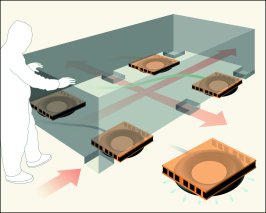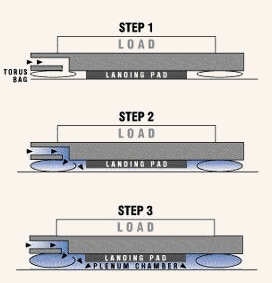| AeroGo air caster equipment uses a variety of
Aero-Casters® to literally float heavy loads on a virtually
frictionless film of air. Air casters provide a clean, quiet and
safe alternative to moving heavy loads. |
|
 |
Reduced friction and omni-directional movement allow the operator to
precisely place and align the load in a limited work space. The low
profile of the air caster Load Module requires less than 3-inch
(76mm) clearance. Air casters will not damage floors and expensive
reinforcement is usually not necessary.
Because we use only basic pneumatic components such as air
regulators and hoses, our products are not only reliable, but will
operate in most environments.
|
| The Aero-Caster Principle |
|
|
|
HOW AEROGO AIR CASTERS WORK: |
|
|
Step 1
Prior to inflation, the load is solidly supported on landing pads.
These pads protect the air caster torus bag from being crushed when
the load is at rest.
|
 |
Step 2
When standard shop air is applied to the air caster, the torus bag
inflates, creating a seal against the floor surface and raising the
load. |
Step 3
When the pressure within the chamber is sufficient to offset the
load's weight, air slowly and evenly escapes between the flexible
torus bag and the floor. The load is literally floated on a thin,
nearly frictionless cushion of air, .003 to .005 inches (.08 to
.13mm) thick. |
LOAD MODULE SYSTEMS
|
|
 |
Load Module Systems move loads of varying sizes,
shapes or weights. Weight capacities 1 to 360 tons utilizing 4 or 6
module configurations. Need to move equipment in a cleanroom
environment? Ask about our anodized or powder coated models.
Load Module Systems Tips:
- Basic Even Loading - Know your load weight and how it's
distributed to move safely. Contact us prior to your next move
if you have any questions.
- Load Modules provide optimal load balance when arranged
under the load in a triangle, square or 6-way pattern.
- Familiarize yourself with your control console it will
facilitate your move over temporary overlays, floor joints or
cracks.
|
|
Click on the link below for further information
such as video demonstrations and literature:
 |
